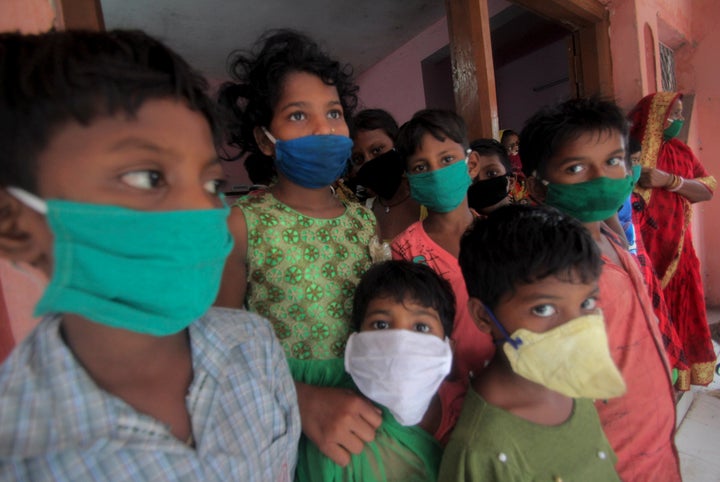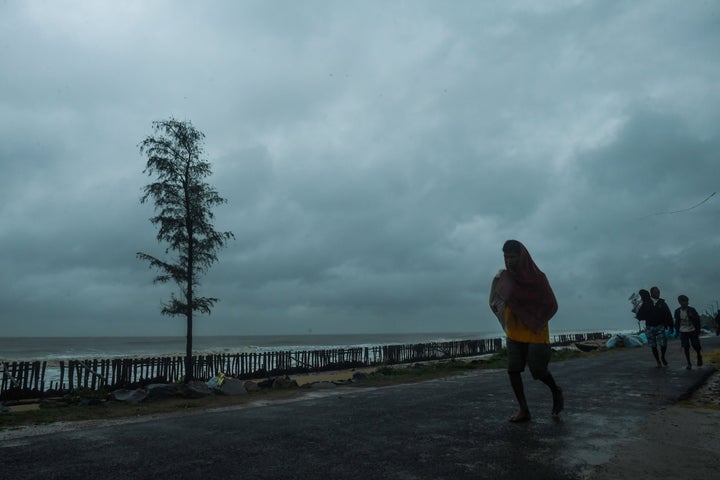NEW DELHI (AP) — A powerful cyclone slammed ashore Wednesday along the coastline of India and Bangladesh where more than 2.6 million people fled to shelters in a frantic evacuation made all the more challenging by the coronavirus pandemic.
Cyclone Amphan, an equivalent of a category-3 hurricane, was packing winds of up to 170 kilometers (105 miles) per hour and maximum gusts of 190 kph (118 mph). Authorities warned it could wreck extensive damage to flimsy houses and a storm surge may push seawater 25 kilometers (15 miles) inland, flooding cities including Kolkata.
The densely populated regions are home to some of the most vulnerable communities in South Asia: poor fishing communities in the Sunderbans and over a million Rohingya refugees living in the crowded camps in Cox’s Bazar in Bangladesh.
The cyclone began to make landfall Wednesday afternoon between Digha, a seaside resort in West Bengal, and Hatiya Islands in Bangladesh. The eye of the storm is likely to pass through the Sunderbans, one of the largest mangrove forests in the world, India’s meteorological department said.
The forests could act as a vital line of defense by dissipating some of the energy from the waves that would otherwise crash into the coastline, said K.J. Ramesh, the department’s former chief.
Bangladesh is attempting to evacuate 2.2 million people to safety. India’s West Bengal state moved nearly 300,000 and Odisha state another 148,486 people, officials said.
In Cox’s Bazar, where the first 10 coronavirus cases were confirmed last week, authorities and U.N. workers prepared 50 shelters and assigned 256 volunteer units.

Areas at risk of landslides were stabilized with bamboo and concrete walls. But the combination of the virus and cyclone could lead to a “new humanitarian crisis,” said Manuel Pereira, deputy chief of mission for the International Organization for Migration in Bangladesh.
“We know that if people are forced to seek communal shelter, they’ll be unable to maintain physical distancing and run the risk of contracting or transmitting the virus,” said Pereira.
Masks and hand sanitizers were hastily added to emergency items in the shelters.
Sobrato Das, a fisherman in Mousuni Island in India, close to the Sunderbans, described the shelters as crowded and said “very few people are wearing masks.”
He said children were crying and women desperately tried to cover their faces with their saris while trying to maintain some distance from each other.
“I have left all my belongings in my house and hope it doesn’t get washed away in the floods,” he said.
Some cyclone shelters in West Bengal were being used for quarantining COVID-19 patients and migrant workers returning to their homes. The state government asked for trains transporting migrants to be suspended, Chief Minister Mamata Banerjee said. Some schools were turned into shelters, news reports said.
Some in the cyclone’s path saw a choice between the virus and the storm.
In the seaside resort of Digha, many people feared going to the shelters, fisherman Debasis Shyamal said. “They have been home for weeks, and are afraid of going into a crowd where they could get infected,” he said.

The densely populated city of Kolkata, which has nearly 1,500 coronavirus cases, is likely to see flooding, while some centuries-old buildings in the northern half of the city could collapse due to the strong winds, officials warned.
The cyclone is bearing down during the Islamic holy month Ramadan, and some Bangladeshis who fasted during the day reportedly waited until the early morning hours before heading for the shelters.
The region is no stranger to devastating cyclones. Ramesh, the former chief of India’s weather agency, said it wasn’t the frequency of cyclones but their intensity that has increased due to climate change patterns.
This has to do with the temperature of the sea’s surface. Warm water is the fuel for cyclones. It is where storms get their energy and the amount of heat trapped in the top 700 meters (2,300 feet) of the ocean has increased. “As a result, cyclones are intensifying faster than before,” he said.
Alam reported from Dhaka, Bangladesh. Associated Press writers Sheikh Saaliq and Chonchui Ngashangva in New Delhi contributed to this report.
A HuffPost Guide To Coronavirus
Calling all HuffPost superfans!
Sign up for membership to become a founding member and help shape HuffPost’s next chapter
Credit: Source link